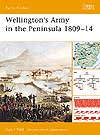Book
Review:
Wellington's Army in the Peninsula, 1809-14
By
Stuart Reid
 With
so many resources being used by Britain to build up and maintain
the Wooden Walls of the Royal navy, the British army was very
much a poor cousin.
With
so many resources being used by Britain to build up and maintain
the Wooden Walls of the Royal navy, the British army was very
much a poor cousin.
And
yet, under the careful and strict hand of Sir Arthur Wellesley,
the Duke of Wellington, Britain's infamous army became a fighting
force with no contemporary equal.
It
has been argued that it may well be the finest ground force ever
at the disposal of a British government.
In
his excellent book Wellington's Army in the Peninsula, 1808-14,
Stuart Reid has a detailed look at the organization, training
and command control of the Peninsular army.
Reid
explains the set-up of Britain's divisions - a new structure -
brigades and battalions.
There
were between two and four brigades of two battalions in each division
and they included Portuguese units that went on to become integral
and valued parts of Wellington's army.
In
charge of the force was Wellington and those responsible for the
feeding, training, supplying and disciplining of the troops -
the Quartermaster General, the Adjutant General and the Commissary
General.
The
QMG's men not only looked after housing and transporting the troops,
but also intelligence gathering and making sure routes of march
were good enough to cope with the heavy traffic of an army. He
also had the Royal Staff Corps and a Corps of Guides.
The
AG's responsibilities were of discipline and communications while
the CG had to organize food - for both men and horses - and non-military
stores and transport.
After examining who ran the army, Reid then looks at the infantry's
tactics and training and has some excellent graphics detailing
drills.
Each
British divisional formation is gone into in depth - its nicknames,
where it fought, its organization, which regiments were put into
it and who commanded.
In
Wellington's Army in the Peninsula, 1808-14 there are some excellent
potted biographies of divisional commanders, including the actions
they were in and their rise through staff ranks.
The
organization of the British artillery is particularly interesting
when you see graphics of how many men and beasts were used to
serve an artillery brigade.
Serving
the six guns were 145 gunners, 100 drivers, 204 horses, eight
ammunition wagons, three baggage wagons, a field forge and a wagon
of spare wheels.
Wellington's
Army in the Peninsula, 1808-14 contains much info than a review
can cover and this volume in the Battle Orders Series from Osprey
will be a boon to anyone wanting to know how Wellington's forces
operated.
-
Richard Moore
8.5/10
Osprey
Website
Osprey PO Box 140,
Wellingborough,
Northants,
NN8 2FA, UK.